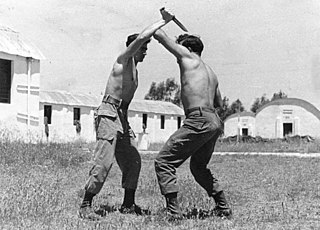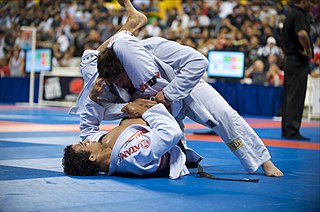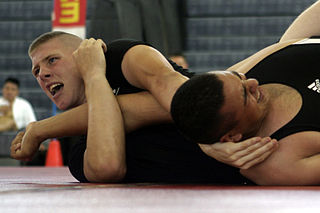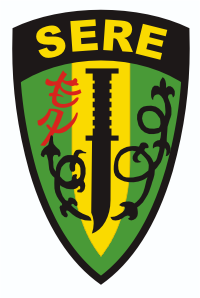
Grappling is a fighting technique as well as a full-contact combat sport based on throws, trips, sweeps, clinch fighting, ground fighting and submission holds.

Krav Maga is an Israeli martial art. Developed for the Israel Defense Forces (IDF), it is derived from a combination of techniques used in aikido, judo, karate, boxing, and wrestling. It is known for its focus on real-world situations and its extreme efficiency. Hungarian-born Israeli martial artist Imi Lichtenfeld, who made use of his training as a boxer and wrestler to defend Jews in Bratislava against fascist groups in the mid-to-late 1930s, developed Krav Maga through his experiences in street fighting. After his immigration to Mandatory Palestine in the late 1940s, he began to provide lessons on combat training to Jewish paramilitary groups that would later form the IDF during the Israeli War of Independence.

Military recruit training, commonly known as basic training or boot camp, refers to the initial instruction of new military personnel. It is a physically and psychologically intensive process, which resocializes its subjects for the unique demands of military employment.

Brazilian jiu-jitsu is a self-defence martial art and combat sport based on grappling, ground fighting, and submission holds. BJJ approaches self-defense by emphasizing taking an opponent to the ground, gaining a dominant position, and using a number of techniques to force them into submission via joint locks or chokeholds.

Submission wrestling, also known as submission grappling, submission fighting or simply grappling, is a competitive martial art and combat sport that focuses on ground fighting and submission techniques. It is a hybrid discipline that incorporates elements of various grappling arts, mostly Brazilian jiu-jitsu but also Judo, Sambo, and wrestling. Submission wrestling is practiced both as a competitive sport and as a training method for self-defence and mixed martial arts (MMA).

The Ranger School is a 62-day United States Army small unit tactics and leadership course that develops functional skills directly related to units whose mission is to engage the enemy in close combat and direct fire battles. Ranger training was established in September 1950 at Fort Benning, Georgia. The Ranger course has changed little since its inception. Until recently, it was an eight-week course divided into three phases. The course is now 61 days in duration and divided into three phases as follows: Benning Phase, Mountain Phase, and Swamp Phase.
The School of Infantry (SOI) is the second stage of initial military training for enlisted United States Marines after recruit training. The ITB now called IMC went from a 59 day course to 16 week course. Since the initial training pipeline is divided between coasts, Marines from areas east of the Mississippi River usually graduate from MCRD Parris Island and move on to SOI at SOI East, while those from the western half of the nation attend MCRD San Diego and move on to SOI West at the Camp San Onofre area of Camp Pendleton in California. Female Marines are trained at both SOI East and SOI West. The School of Infantry's training mission ensures "Every Marine is, first and foremost, a Rifleman". At SOI, Marines with the Military Occupational Specialty of infantry are trained at the Infantry Training Battalion (ITB), while all non-infantry Marines are trained in basic infantry and combat skills at the Marine Combat Training Battalion. SOI marks a transition in the professional training of entry-level students from basically trained Marines to combat-ready Marines.

Hand-to-hand combat is a physical confrontation between two or more persons at short range that does not involve the use of weapons. The phrase "hand-to-hand" sometimes include use of melee weapons such as knives, swords, clubs, spears, axes, or improvised weapons such as entrenching tools. While the term "hand-to-hand combat" originally referred principally to engagements by combatants on the battlefield, it can also refer to any personal physical engagement by two or more people, including law enforcement officers, civilians, and criminals.
Hwa Rang Do, also known as "The Way of the Flowering Knights", is a comprehensive Korean martial art that was developed in the 1960s by Joo Bang Lee and his brother Joo Sang Lee. It has multiple areas of focus, including stand-up fighting with open-hand striking, weapons, throws and takedowns; ground fighting; various types of meditative practices; intellectual and character development; and artistic and cultural pursuits.

The Marine Corps Martial Arts Program is a combat system developed by the United States Marine Corps to combine existing and new hand-to-hand and close quarters combat techniques with morale and team-building functions and instruction in the warrior ethos. The program, which began in 2001, trains Marines in unarmed combat, edged weapons, weapons of opportunity, and rifle and bayonet techniques. It also stresses mental and character development, including the responsible use of force, leadership, and teamwork.

Survival, Evasion, Resistance, and Escape (SERE) is a training program, best known by its military acronym, that prepares U.S. military personnel, U.S. Department of Defense civilians, and private military contractors to survive and "return with honor" in survival scenarios. The curriculum includes survival skills, evading capture, application of the military code of conduct, and techniques for escape from captivity. Formally established by the U.S. Air Force at the end of World War II and the start of the Cold War, it was extended to the Navy and United States Marine Corps and consolidated within the Air Force during the Korean War with greater focus on "resistance training".
Jujutsu techniques include joint locks, chokeholds, strikes, grappling, throwing and other self-defense techniques.

The United States Army Armor School is a training school located at Fort Moore, Georgia. Its primary focus is the training of United States Army soldiers, non-commissioned officers, warrant officers, and commissioned officers. It also trains for equipment handling, including the M1 Abrams, the Bradley Fighting Vehicle, and the Stryker Mobile Gun System. The Armor School moved to Fort Benning in 2010 as part of the United States Base Realignment and Closure program.

United States Army Basic Combat Training (BCT) is the recruit training program of the United States Army, for service in the U.S. Army, U.S. Army Reserve, or the Army National Guard.

Combat Hapkido is an eclectic modern Hapkido system founded by John Pellegrini in 1990. Taking the next step in 1992 Pellegrini formed the International Combat Hapkido Federation (ICHF) as the official governing body of Combat Hapkido. Later, in 1999, the ICHF was recognized by the Korea Kido Association and the World Kido Federation, collectively known as the Kido Hae, as the Hapkido style Chon Tu Kwan Hapkido. The World Kido Federation is recognized by the Government of South Korea as an organization that serves as a link between the official Martial Arts governing body of Korea and the rest of the world Martial Arts community. The founder of Combat Hapkido was very clear in his statement that he did not invent a new martial art. He stated "I have merely structured a new Self-Defense system based upon sound scientific principles and modern concepts. For this reason Combat Hapkido is also referred to as the "Science of Self-Defense". Combat Hapkido is a new interpretation and application of a selected body of Hapkido techniques. The word "Combat" was added to Combat Hapkido to distinguish this system from Traditional Hapkido styles and to identify its focus as Self-Defense.

The Army Mountain Warfare School (AMWS) is a United States Army school located at the Camp Ethan Allen Training Site, Jericho, Vermont to train soldiers in mountain warfare, the specialized skills required for operating in mountainous terrain. It is home to the 86th Infantry Brigade Combat Team. The school is located in Vermont's Green Mountains.

The Special Forces Qualification Course (SFQC) or, informally, the Q Course is the initial formal training program for entry into the United States Army Special Forces. Phase I of the Q Course is Special Forces Assessment and Selection (SFAS). Getting "Selected" at SFAS will enable a candidate to continue to the next of the four phases. If a candidate successfully completes all phases they will graduate as a Special Forces qualified soldier and then, generally, be assigned to a 12-men Operational Detachment "A" (ODA), commonly known as an "A team." The length of the Q Course changes depending on the applicant's primary job field within Special Forces and their assigned foreign language capability but will usually last between 56 and 95 weeks.

Emerson Combat Systems is a form of modern combatives designed by Ernest Emerson. The system is based on Emerson's accumulated 35 years of study of martial arts and combat and incorporates empty hand training as well as use of weapons from knives and sticks to rifles and pistols. In the United States, this system is taught to military, law enforcement, and civilians.

The Army Reserve Officer Training Corps (AROTC) is the United States Army component of the Reserve Officers' Training Corps. It is the largest Reserve Officer Training Corps (ROTC) program which is a group of college and university-based officer training programs for training commissioned officers for the United States Army and its reserves components: the Army Reserves and the Army National Guard. There are over 30,000 Army ROTC cadets enrolled in 274 ROTC programs at major universities throughout the United States. These schools are categorized as Military Colleges (MC), Military Junior Colleges (MJC) and Civilian Colleges (CC).

Jieitaikakutōjutsu is a military self-defence and fighting system developed for JSDF personnel. The system primarily consists of hand-to-hand combat, bayonet and knife fighting principles.





















